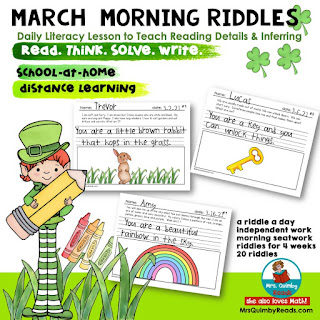 |
| March Morning Riddles |
MARCH MORNING RIDDLES
20 March riddles for your students to read, think, write, and solve. These riddles are a great writing activity for morning seatwork. Students settle right in with reading and writing. It is motivating because the children love to guess the answer to today's riddle. You can easily assign these riddles for distance learning and school-at-home work.
Each riddle is a March theme idea and contains many high-frequency words. Your students read the riddle, think, and write a sentence that answers the question. Next, they illustrate the sentence that they wrote. This is a motivating writing-reading-thinking literacy activity that you may use for morning seatwork, homework, for fast finishers, or anytime. This resource includes teacher directions, bin labels, and an answer key. Also, if you wish to make a 'March Riddle' booklet, there are covers. It is appropriate for grades 1 -2 and homeschoolers.
Be sure to click read more for more March Resouces; don't miss them
How to include a morning riddle in your daily routine:
- When students arrive each morning, they ready themselves to start the day. Riddles are in a bin on a shelf.
- Students bring their morning riddle to their tables or desks.
- Students start to read, and it will warm your heart to see independent readers already reading, even before attendance has been taken.
- Allow students to help each other with the reading.
- The natural talk begins.
- You will start to hear, "I know what it is?"
- Students begin drawing and writing to show the answer.
- Later, you can show the riddle with your document camera or whiteboard.
- Read as a whole group.
- Talk about the answers.
- Underline any keywords that helped to solve the riddle.
- Circle any key sight words you wish to teach and review.
- Teach interactive writing. Writing skills to focus on might be:
- complete sentences
- capital letters
- punctuation
- spelling
Occasionally, have your students complete daily word work or other focused reading skills on the back of the page. i.e., teaching a spelling or grammar rule
When these morning riddles become part of your morning routine, you will notice:
- students focused on the text
- students readily and willing to read
- students thinking
- students helping students
- writing improvement
March Morning Riddles Theme focus:
- wind
- Rainbow
- leprechaun
- spring
 |
| That's What Leprechauns Do |
That's What Leprechauns Do, by Eve Bunting. Book companion and reader response pages for literacy lessons with literature. This book is a charming story about leprechauns and the mischief they get into, and these pages can help your students write about their reading, complete word work, and practice handwriting. There are 20 pages to respond in writing to this fun St. Patrick's Day story. It's a favorite, and children love to learn about leprechauns and the folklore that has been enjoyed for many years. There are pages for beginning and more experienced writers, so you can diversify instruction and assign these pages for distance learning and school-at-home.
Literacy Skills Focus on:
- remembering story events
- comprehension check - short answer
- writing about Leprechauns
- What do Leprechauns do?
- easy fill-in-blank activity
- Four Fascinating Facts about Rainbows
- Writing - "How to Catch a Leprechaun"
- making new words
- rhyming words
- cut and paste - ABC order
- easy writing prompts
- handwriting practice
- teacher tips to use with this book
- 20 total pages
 |
| There Was an Old Lady Who Swallowed a Clover! |
Teaching literacy with There Was An Old Lady Who Swallowed A Clover, by Lucille Colandro. Make an interactive reading booklet which provides the opportunity to retell the story, read for fluency and talk about books and reading at home. Over 30 pages to use with this fun book that children love. Talk about make-believe and fiction. Silly and absurd! And perfect for St. Patrick's Day!
Enjoy good books!
This book companion includes:
- ask and answer questions
- interactive reading booklet
- remembering the story events
- learning new words - cards for display
- color and write about the story
- word work
- phonics
- sight words
- cut and paste
- color and write
- teacher directions
This book is wonderful to read aloud to young readers who are learning about literacy and books.
This book companion is to be used with the book,
There was an Old Lady Who Swallowed A Clover by Lucille Colandra.
 |
| 4 Square - St. Patrick's Day |
Enjoy this teaching resource for responding to books about St. Patrick's Day.
Two pages:
4-square to write about any book aboutSt. Patrick's Day.
4 square to list details about Gail Gibbons' book on St. Patrick's Day
Focus Skills:
- reading informational text about St. Patrick's Day
- learning to revisit the text to glean details about the book
- reading comprehension
- handwriting practice
- finding important details
What fun! Writing is a great way to respond to a St. Patrick's Day story. Children love to learn about leprechauns and the folklore that has been enjoyed for many years.
This teaching resource is to be used with the book,
St. Patrick's Day, by Gail Gibbons, or any book about St. Patrick's Day


